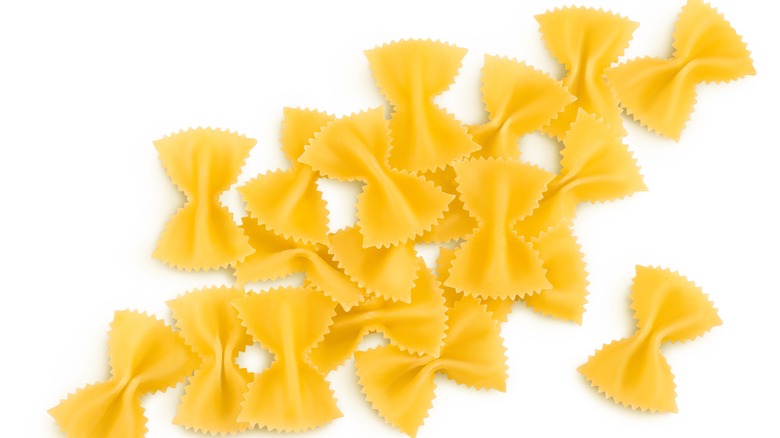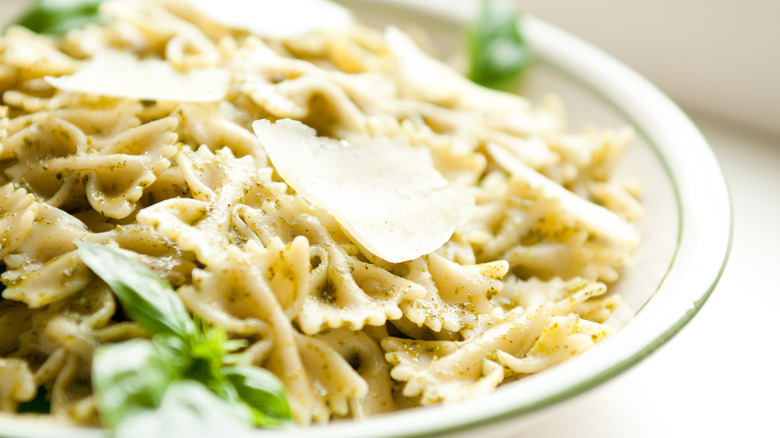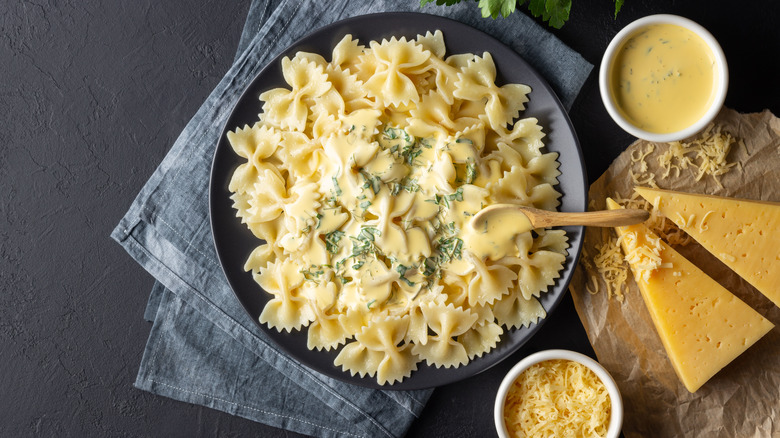The Simple Reason Farfalle Pasta Got Its 'Butterfly' Nickname
Farfalle (pronounced fahr-fah-ley) is a culinary Rorschach test of sorts. What shape do you see if you are presented with a plate of farfalle pasta, with its pinched center and fanned pleats? Both a butterfly and a bow tie are common answers and both can be correct. The name "farfalle" comes from the Italian word for butterflies and it does indeed resemble a butterfly with its wings spread open. But in our modern world with formal dress codes, it also resembles a bow tie, hence its nickname of bow tie pasta.
Farfalle originated in the Lombardia and Emilia-Romagna regions of Northern Italy in the 1500s, back when Italians seemingly named pasta shapes based on their resemblance to living things. Vermicelli translates to little worms and lumache translates to snails, so it is understandable why people would name farfalle pasta after a beautiful insect.
Farfalle is typically made with all-purpose flour, a bit of semolina flour, egg, and a bit of olive oil, but not all the shapes are identical. The small ones are called farfalline and the larger ones are called farfallone. There are even varieties with ridges called farfalle rigate.
Making farfalle from scratch can be a laborious process
In the world of pasta, long-strand varieties like fettuccine are often the go-to shape for home cooks because they are easy to make.
In comparison, making farfalle is a multi-step process and not something that can be made in bulk. It starts by rolling out the pasta dough into thin sheets and then cutting it into small squares. To get the pasta's ruffled edges, use a pair of pinking shears or a fluted pastry cutter and then pinch it in the center to create a pleated or winged effect. This can be labor intensive since it requires crafting individual pieces of pasta.
There is one minor hitch to making farfalle at home. When you pinch the pasta square to create the pleat, it results in a thick center which needs more time to cook compared to the rest of the shape. The suggestion from the Food Network is to fold the dough, "so that when you press it in the middle, you have three layers of pasta on top of each other."
Pair farfalle with pasta salad or chunky sauces
If all this sounds like too much trouble, consider buying a box of farfalle from your local supermarket to experiment with a new pasta shape and recipe. One of the biggest draws for farfalle pasta is that it is visually appealing, especially for kids who associate it with the butterflies they are named for.
From a practical sense, farfalle is commonly used in pasta salads because its folded shape makes it easy to scoop all the flavors in the salad and dressing. You can toss it with fresh vegetables (e.g. tomatoes and cucumbers), cheese (e.g. bocconcini), herbs, and a vinaigrette or dressing. Pesto is a great choice for a light, yet carb-filled pasta dish.
Farfalle's large surface area, pleated shape, and ridges also help it hold onto sauces, making it a great choice for a creamy Alfredo sauce or a chunky marinara that can cling to the pasta. Cue this timeless insult from The Golden Girls, "may your marinara sauce never cling to your pasta!" In this case, we hope it does.


